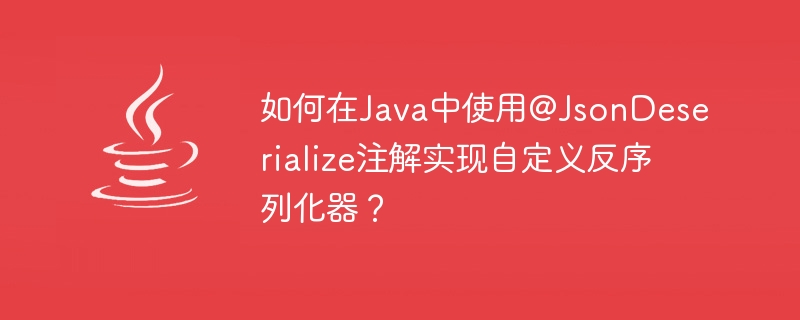Maison >Java >javaDidacticiel >Comment implémenter un désérialiseur personnalisé à l'aide de l'annotation @JsonDeserialize en Java ?
Comment implémenter un désérialiseur personnalisé à l'aide de l'annotation @JsonDeserialize en Java ?
- 王林avant
- 2023-08-25 19:29:051478parcourir
L'annotation

@JsonDeserialize est utilisée pour déclarer un désérialiseur personnalisé lors de la désérialisation de JSON en objets Java. Nous pouvons implémenter un désérialiseur personnalisé en étendant la classe StdDeserializer en utilisant le type générique Employee, et devons remplacer la méthode deserialize() de la classe StdDeserializer .
Syntaxe
@Target(value={ANNOTATION_TYPE,METHOD,FIELD,TYPE,PARAMETER})
@Retention(value=RUNTIME)
public @interface JsonDeserializeDans le programme suivant, nous pouvons utiliser l'annotation @JsonDeserialize pour implémenter un désérialiseur personnalisé
Exemple
import java.io.*;
import com.fasterxml.jackson.core.*;
import com.fasterxml.jackson.databind.*;
import com.fasterxml.jackson.databind.annotation.*;
import com.fasterxml.jackson.databind.deser.std.*;
public class JsonDeSerializeAnnotationTest {
public static void main (String[] args) throws JsonProcessingException, IOException {
Employee emp = new Employee(115, "Adithya");
ObjectMapper mapper = new ObjectMapper();
String jsonString = mapper.writeValueAsString(emp);
emp = mapper.readValue(jsonString, Employee.class);
System.out.println(emp);
}
}
// CustomDeserializer class
class CustomDeserializer extends StdDeserializer<Employee> {
public CustomDeserializer(Class<Employee> t) {
super(t);
}
public CustomDeserializer() {
this(Employee.class);
}
@Override
public Employee deserialize(JsonParser jp, DeserializationContext dc) throws IOException, JsonProcessingException {
int id = 0;
String name = null;
JsonToken currentToken = null;
while((currentToken = jp.nextValue()) != null) {
switch(currentToken) {
case VALUE_NUMBER_INT:
if(jp.getCurrentName().equals("id")) {
id = jp.getIntValue();
}
break;
case VALUE_STRING:
switch(jp.getCurrentName()) {
case "name":
name = jp.getText();
break;
default:
break;
}
break;
default:
break;
}
}
return new Employee(id, name);
}
}
// Employee class
@JsonDeserialize(using=CustomDeserializer.class)<strong>
</strong>class Employee {
private int id;
private String name;
public Employee(int id, String name) {
this.id = id;
this.name = name;
}
public int getId() {
return id;
}
public String getName() {
return name;
}
@Override
public String toString() {
StringBuilder sb = new StringBuilder("ID: ").append(this.id).append("\nName: ").append(this.name);
return sb.toString();
}
}Output
ID: 115 Name: Adithya
Ce qui précède est le contenu détaillé de. pour plus d'informations, suivez d'autres articles connexes sur le site Web de PHP en chinois!

